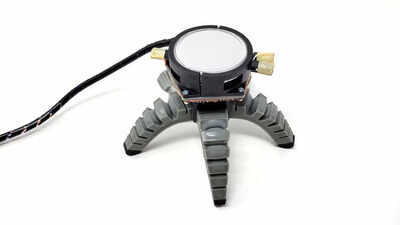- News
- Science News
- Biohybrid robots: The future of living machines powered by mushrooms
Biohybrid robots: The future of living machines powered by mushrooms
Engineers at Cornell and Florence University have developed a pioneering biohybrid robot powered by living fungi. Using electrical signals from the king trumpet mushroom, the robot can move and interact with its environment. This innovation opens new possibilities for agriculture and environmental monitoring by combining biological materials with synthetic robotics for adaptive responses to stimuli like light.

Image source: Cornell chronicle- Cornell university
The integration of biological components with synthetic robotics opens new possibilities, particularly for agricultural and environmental applications.
A new era of robotics: Mushroom Biohybrid
The robot is a part of a developing field that combines biological materials with engineered systems. It was developed by a combined team from the US and Italy. According to a report by Anand Mishra, a research associate at Cornell's Organic Robotics Lab, "Living systems respond to touch, light, and heat." "By utilising these systems, robots can manoeuvre through unpredictable environments."
Thanks to this breakthrough, agricultural methods could be revolutionised by robots that can sense changes in the environment or soil chemistry. Through the integration of mycelium into the robot's electronics, scientists were able to construct an environment-adaptive apparatus.
The potential is highlighted by Cornell mechanical and aerospace engineering professor Rob Shepherd, who says, "This could mitigate downstream effects of agriculture, like harmful algal blooms."
Mushroom as Biohybrid components
The king trumpet mushroom's mycelium was selected due to its adaptability and capacity to grow in a range of conditions. These root-like structures, which could generate tiny electrical signals, took 14 to 33 days to combine with the robot's circuitry.
The difficulty was in receiving these data and translating them into actuator commands for the robot. The robot responded dynamically to its surroundings by adjusting its movements in response to UV light stimulation.
Applications and ethical considerations of Biohybrid robots
Biohybrid robots may have revolutionary uses, particularly in environmental monitoring and agriculture. One day, mycelium-powered robots that are sensitive to chemical and biological cues could be used to monitor soil conditions and investigate aquatic environments.
Although biohybrid technology is promising, moral considerations need to be made. Despite the nascent stage of this technology, researchers are cognisant of the imperative for conscientious development and implementation. The boundaries between biology and robots are being blurred by this research, which was published in Science robots.
Also read: 11 best accidental inventions of all time: What, why and how explained

About the Author
TOI Science DeskEnd of Article
FOLLOW US ON SOCIAL MEDIA
